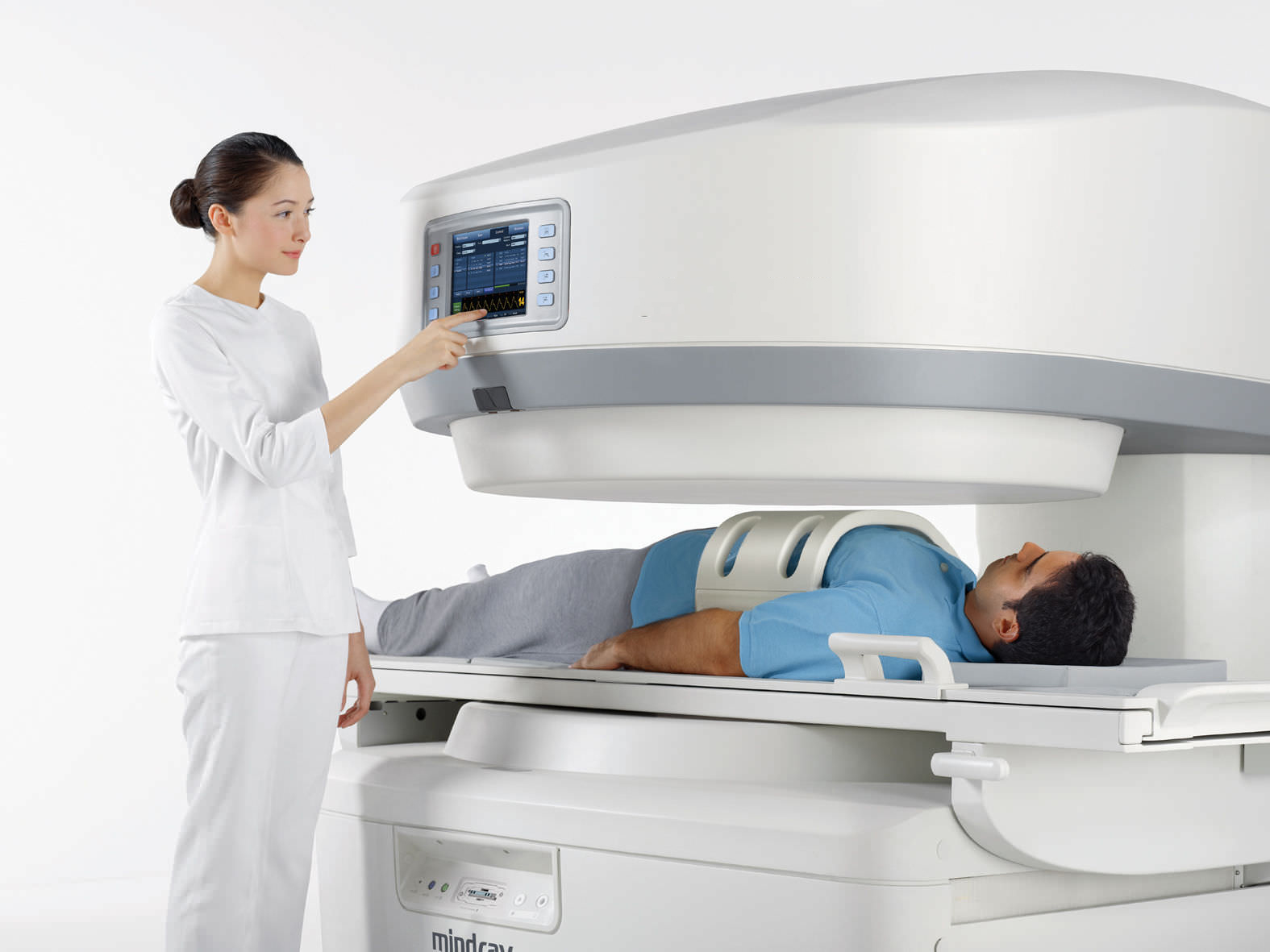Q: What is Open MRI?
A: Open MRIs are patient-friendly alternatives to “tunnel, “tube,” or “closed” High-Field MRIs. High-Field MRIs have exceptionally powerful magnetic fields and can produce very high resolution pictures, but they require patients to lie down in a cylinder-like space that is very noisy and, for many, intolerably claustrophobic. The less powerful Open MRIs may not match the resolution of High-Field scanners, but they are capable of producing high-quality diagnostic images, and they provide patients with a relatively pleasant MRI exam. Health Diagnostic MRI offers a variety of Open MRIs, including the Hitachi Aries, The GE OpenSpeed, and the FONAR QUAD 12000.
For the ultimate in patient comfort, Health Diagnostics also offers the FONAR Stand-UP MRI.
Q: What is MRI?
A: MRI stands for Magnetic Resonance Imaging. An MRI scanner allows physicians to look inside the body without using surgery, harmful dyes, or X-rays. The MRI scanner uses magnets, radio waves and computers to produce very clear pictures, or images, of the human anatomy. MRI images depict soft tissue anatomy far better than any other diagnostic imaging equipment.
Q: What is MRI used for?
A: Because MRI makes such detailed pictures of soft-tissue structures near and around bones, it is ideal for spinal and joint problems. MRI is widely used to diagnose sports-related injuries, especially those affecting the knee, shoulder, hip, elbow and wrist. MRI images allow physicians to see very small tears and injuries to ligaments and muscles.
In addition, MRI of the heart, aorta, coronary arteries and blood vessels is a quick, noninvasive tool for diagnosing coronary artery disease and heart problems. Physicians can examine the size and thickness of the chambers of the heart and determine the extent of damage caused by a heart attack or progressive heart disease.
Organs of the chest and abdomen—including the lungs, liver, kidney, spleen, pancreas and abdominal vessels—can also be examined in high detail with MRI, enabling the diagnosis and evaluation of tumors and functional disorders. MRI is growing in popularity as an alternative to traditional x-ray mammography in the early diagnosis of breast cancer. Because no radiation exposure is involved, MRI is often the preferred diagnostic tool for examination of the male and female reproductive systems, pelvis and hips and the bladder.
Q: Can anybody have an MRI? Any dangers?
A: An MRI scan can be dangerous for certain people.
- If you have a cardiac pacemaker, you should not have an MRI scan. It can be fatal. This is because there may be certain parts in the pacemaker that may be adversely affected by the magnetic field of the MRI scanner, causing the apparatus to malfunction or cease operating. Even someone accompanying a patient must not be allowed in the MRI scanner room if he/she has a pacemaker.
- Do not have an MRI exam if you are pregnant or possibly pregnant.
- Aneurysm clips in the brain. Some aneurysm clips are MRI safe; some aren’t. You must check with the surgeon who installed the clip to be sure the manufacturer has tested it and found it to be “MRI Safe.”
- Other Potential Dangers:
Neurostimulators
Heart Valves
Metal Implants
Drug Infusion Device/Pump
Ear Implants
Hearing Aid (The MRI can damage it.)
Inferior Vena Cava Filter
Metal Objects in Eyes
Surgical Staples or Wires
Bone or Joint Replacements
Metal Plates, Rods, Pins or Screws
Contraceptive Diaphragms or Coils
Permanent Dentures
Penile Implants
Shrapnel
Vascular Coils and Filters
If any of the above applies to you, it might be DANGEROUS for you to have an MRI exam. Be sure to make the technologist and staff at the MRI center aware, and also tell the doctor who prescribed the MRI exam. They will be able to tell you if it is safe for you to have the MRI exam. In most cases you will be able to have the scan, but please leave that decision to the professionals.
Q: Can somebody come into the MRI room with me?
A: Yes, but only if the person does not have a cardiac pacemaker. It is common for a parent to stay with a child. In fact, we encourage it.
Q: How do I prepare for an MRI?
A:
- First be certain that it is safe for you to have an MRI scan. If you are not certain, click here.
- When you come to the office for the exam, bring your insurance information, your doctor’s prescription and your driver’s license.
- Unless your doctor tells you otherwise, you may take your medications as usual. There are no food or drink restrictions.
- Wear the right clothing. Metal objects on your person can degrade or ruin MRI pictures. Wear comfortable, loose fitting clothing (no dresses or skirts for modesty reasons), but keep in mind that metal must be avoided in or near the region where you are going to be scanned. “Sweats” are recommended.
If you are going to have a scan of the lower spine (lumbar spine) or the abdomen area, don’t wear clothing or under-clothing that has metal on it in that area. For example, a body suit that has snaps in the crotch, or pants with fasteners or a zipper will cause a problem. Sweats with no eyelets would be fine. Also, body-pierced jewelry in that region must be removed.
If you are having a scan in the head or neck area, remove all makeup (some makeup has metallic particles in it) and all metallic items such as hair clips, earrings, and facial jewelry, including body-pierced items. Notify the technologist if you have any facial tattoos, such as eyeliner or eyebrow tattoos.
If you are having a scan in the chest area, or upper torso, avoid clothing and under-clothing with metal hooks or fasteners. For example, a sweatshirt with metallic decorations or body-pierced jewelry in that region will cause a problem
But don’t worry. If you don’t have suitable clothing, we will give you a gown.
- Leave all removable metallic objects outside the scanning room.
- cell phones
- pagers
- jewelry
- keys
- watches
- coins
- eyeglasses
- hearing aids
- dentures and prosthetic devices
- credit/bank cards (The MRI can corrupt the information stored on them)
Q: Do I need a doctor’s prescription?
A: Yes!
Q: What will the staff want to know about me?
A: The receptionist and MRI technologist will ask you questions about your medical history. They will check to see if it is safe for you to have an MRI scan. If you are not sure if it is safe for you. Bring your insurance card, your doctor’s prescription, and your driver’s license.
Q: What will I experience during the MRI exam?
A: Depending on the type of scan your doctor ordered, the MRI technologist may wrap a special belt (actually an antenna) around the region of your body that is to be scanned. If you are having a head scan, your head will rest in a special fixture. Once you are comfortably positioned, the technologist will start the scan.
Once the scan has been initiated, all you have to do is be as still as you can until the MRI exam is over – the stiller the better. The reason you have to lie still is because movement blurs the MRI images. If you move too much, the pictures will be too blurry for the radiologist to see what he needs to see, and you will have to reschedule for another MRI exam.
Depending on what your doctor ordered and the area being scanned, the procedure will take between 15 and 45 minutes. The MRI technologist will be able to tell you how long it should take.
You won’t feel anything, but you will hear some low-volume, rumbling noises throughout the scan. These sounds are normal. The Stand-Up MRI is very quiet in comparison to “tunnel” MRI scanners.
A microphone will be placed near you so you will be able to speak to the staff at any time during the exam.
Q: Will I be able to drive after I have the exam?
A: Yes. The MRI has no known physiological side effects. However, if you have taken a sedative, there may be some restrictions.
Q: When will I find out the results?
A: You won’t find out at the time of the scan. The results or your MRI examination will be faxed and/or mailed directly to your doctor, normally within 24 hours. In turn, your doctor will explain them to you. Technologists are not qualified to interpret MRI examinations, nor are they allowed to, so please don’t ask them for their opinions.

